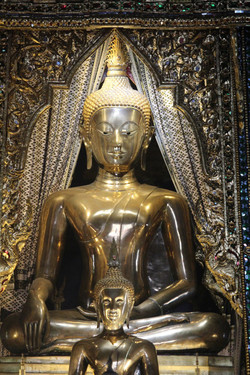ค้นหางานศิลปกรรม
ฐานข้อมูลศิลปกรรมในเอเชียตะวันออกเฉียงใต้
พระเสริม
คำสำคัญ :
| ชื่อหลัก | วัดปทุมวนาราม |
|---|---|
| ประเภทงานศิลปะ | ประติมากรรม |
| ตำบล | ปทุมวัน |
| อำเภอ | เขตปทุมวัน |
| จังหวัด | กรุงเทพมหานคร |
| ภาค | ภาคกลาง |
| ประเทศ | ไทย |
| พิกัดภูมิศาสตร์ ค่าองศาทศนิยม | Lat : 13.745928 Long : 100.536587 |
| พิกัดภูมิศาสตร์ พิกัดกริด | Zone : 47 P Hemisphere : N E : 666135.7 N : 1520156.94 |
| ตำแหน่งงานศิลปะ | พระพุทธรูปประธานในพระวิหาร |
| ประวัติการสร้าง | ไม่ปรากฏประวัติการสร้างแต่จากรูปแบบน่าจะสร้างขึ้นกลาง – ปลายพุทธศตวรรษที่ 21 |
|---|---|
| กระบวนการสร้าง/ผลิต | หล่อสำริด |
| ประวัติการอนุรักษ์ | ประกาศขึ้นทะเบียนโบราณสถานในราชกิจจานุเบกษา เล่มที่ 66 ตอนที่ 64 วันที่ 22 พฤศจิกายน 2492 |
| ขนาด | หน้าตักกว้าง 2 คืบ 8 นิ้ว สูง 4 คืบ 1 นิ้ว |
| ลักษณะทางศิลปกรรม | พระพุทธรูปองค์นี้ประทับนั่งขัดสมาธิราบปางมารวิชัย ขมวดพระเกศาเล็ก รัศมีเป็นเปลวไฟ พระพักตร์รูปไข่และเล็ก พระนลาฏแคบ พระขนงโก่ง พระนาสิกเล็กและโด่ง พระวรกายบอบบาง สังฆาฏิเป็นแผ่นใหญ่ยาวถึงพระนาภีปลายคล้ายเขี้ยวตะขาบ นิ้วพระหัตถ์เล็กเรียวยาวเสมอกัน |
| ข้อมูลที่สำคัญทางวิชาการ | ตัวอย่างพระพุทธรูปศิลปะล้านช้างในกรุงเทพมหานครที่มีตำนานสัมพันธ์กับพระใส |
| ข้อสังเกตอื่นๆ | พระเสริมมีพุทธลักษณะคล้ายกับพระเจ้าองค์ตื้อ วัดศรีชมภูองค์ตื้อ ซึ่งเป็นตัวอย่างของพระพุทธรูปในศิลปะล้านช้างที่ยังมีอิทธิพลของศิลปะล้านนาหลายประการ ต่างจากพระพุทธรูปศิลปะล้านช้างรุ่นหลังที่เน้นเส้นต่างๆ บนพระพักตร์เป็นร่องลึก พระโอษฐ์เล็กและขอบพระโอษฐ์หนา พระวรกายเพรียวบาง นิ้วพระหัตถ์ใหญ่และยาวเท่ากัน |
| สมัย/รูปแบบศิลปะ | ล้านช้าง |
| อายุ | กลาง – ปลายพุทธศตวรรษที่ 21 |
| ศาสนา | พุทธ |
| ลัทธิ/นิกาย | เถรวาท |
| ศาสนา/ความเชื่อที่เกี่ยวข้อง | พุทธศาสนาเถรวาท |
| ตำนานที่เกี่ยวข้อง | ตำนานกล่าวว่าพระใสถูกสร้างขึ้นโดยพระธิดาสามพี่น้องของพระเจ้าไชยเชษฐาธิราช ในปี พ.ศ. 2109 พร้อมกับพระสุกและพระใส โดยตั้งชื่อตามพระนามของพระธิดาทั้ง 3 โดยในระหว่างการหล่อได้มีตาผ้าขาวมาช่วยสูบเตาหลอมทองและมีห่วงกลมขนาดเท่านิ้วมือที่ฐานของพระใสจำนวน 3 ห่วง เมื่อหล่อเสร็จ พระพุทธรูปทั้ง 3 ก็ประดิษฐานอยู่ที่วัดโพนชัยในอาณาจักรล้านช้างเรื่อยมา เมื่อใดที่เกิดศึกสงคราจะมีการนำพระพุทธรูปทั้ง 3 ไปซ่อนไว้ยังถ้ำบนภูเขาควาย เมื่อสงครามสงบจึงอัญเชิญกลับมาที่เดิม หลังจากนั้นเจ้าสุริยุมารได้ทรงอธิษฐานกับพระใสว่าหากบ้านเมืองจะสงบสุขขอให้พระใสแสดงปาฏิหาริย์ เมื่อทรงขึ้นครองราชย์เป็นพระเจ้าสุริยวงศาธรรมิกราช ก็ได้เกิดเหตุอัศจรรย์ขึ้นจริงๆ ต่อมาในสมัยรัชกาลที่ 3 ได้มีการอัญเชิญพระพุทธรูปทั้ง 3 องค์ข้ามแม่น้ำโขง แต่พระสุกจมน้ำไปเหลือเพียง 2 องค์ และได้นำไปประดิษฐานยังวัดโพธิ์ชัย ก่อนที่จะอัญเชิญลงมายังกรุงเทพมหานครในสมัยพระบาทสมเด็จพระจอมเกล้าเจ้าอยู่หัว โดยในคราวแรกประดิษฐานอยู่ภายในพระบวรราชวังก่อนจะอัญเชิญมาไว้ยังวัดปทุมวนาราม ซึ่งจากพุทธศิลป์ พระเสริมเป็นพระพุทธรูปที่อาจจะสร้างขึ้นในรัชกาลของพระเจ้าไชยเชษฐาธิราชก็ได้ต่างจากพระใส วัดโพธิ์ชัย จังหวัดหนองคายที่มีอายุสมัยหลังลงมา |
| งานศิลปะที่เกี่ยวข้อง | 1. พระใส วัดโพธิ์ชัย จังหวัดหนองคาย พระพุทธรูปที่ตามตำนานระบุว่าสร้างขึ้นพร้อมกัน แต่จากพุทธศิลป์แล้วน่าจะมีอายุสมัยหลังลงมา คือ ปลายพุทธศตวรรษที่ 22 – ต้นพุทธศตวรรษที่ 23 2. พระเจ้าองค์ตื้อ วัดศรีชมภูองค์ตื้อ จังหวัดหนองคาย พระพุทธรูปสำคัญที่สร้างในรัชกาลของพระเจ้าไชยเชษฐิราชและมีพุทธศิลป์ใกล้เคียงกับพระเสริม |
| รูปแบบลิขสิทธิ์ | Attribution-NonCommercial-NoDerivs (CC BY-NC-ND) |
|---|---|
| เจ้าของสิทธิ์ | ศูนย์มานุษยวิทยาสิรินธร (องค์การมหาชน) |
| วันที่จัดทำข้อมูล | 2008-08-18 |
| ผู้จัดทำข้อมูล | ธนภัทร์ ลิ้มหัสนัยกุล |
| บรรณานุกรม | ศักดิ์ชัย สายสิงห์. เจดีย์ พระพุทธรูป ฮูปแต้ม สิม ศิลปะลาวและอีสาน. กรุงเทพฯ: มิวเซียมเพรส, 2555. ประภัสรร์ ชูวิเชียร. ศิลปะลาว. กรุงเทพฯ: มติชน, 2557. ศักดิ์ชัย สายสิงห์. พระพุทธรูปในประเทศไทย : รูปแบบ พัฒนาการ และความเชื่อของคนไทย. กรุงเทพฯ: ภาควิชาประวัติศาสตร์ศิลปะ คณะโบราณคดี มหาวิทยาลัยศิลปากร, 2556. เจริญ ตันมหาพราน. พระพุทธรูปล้านช้าง. กรุงเทพฯ: ปราชญ์, 2554. |


